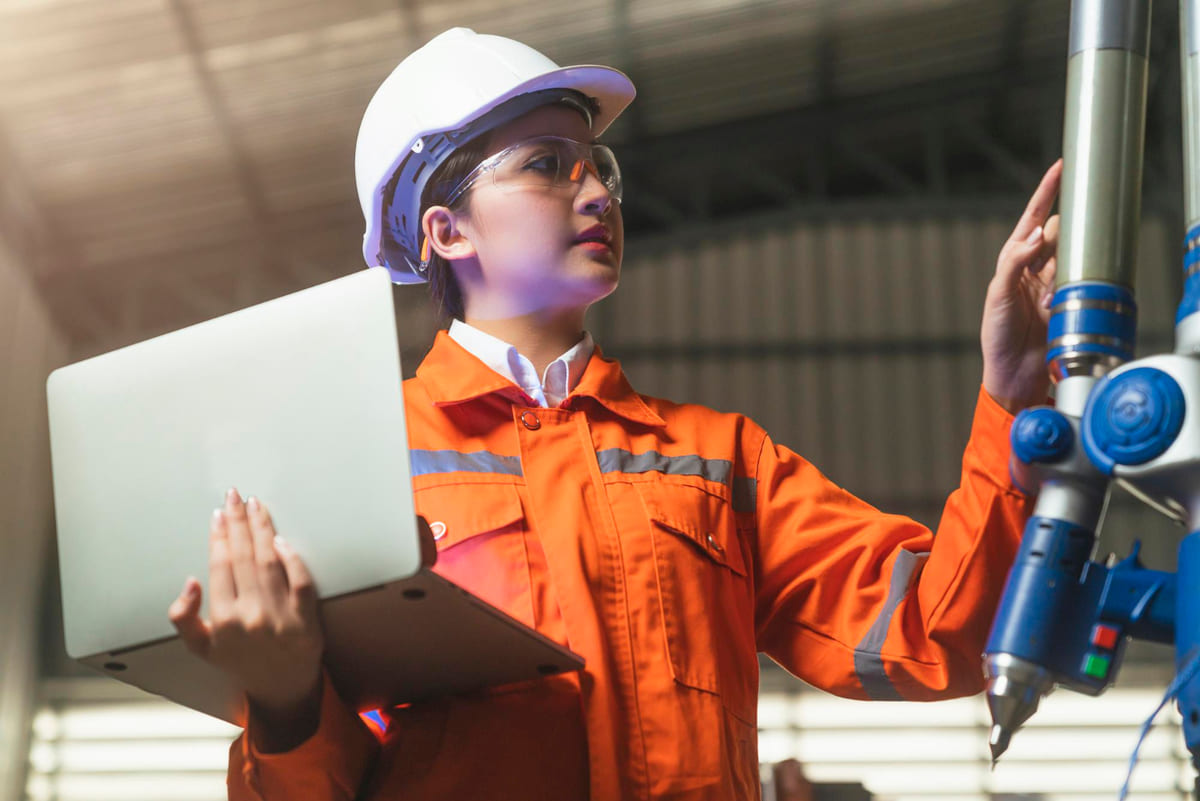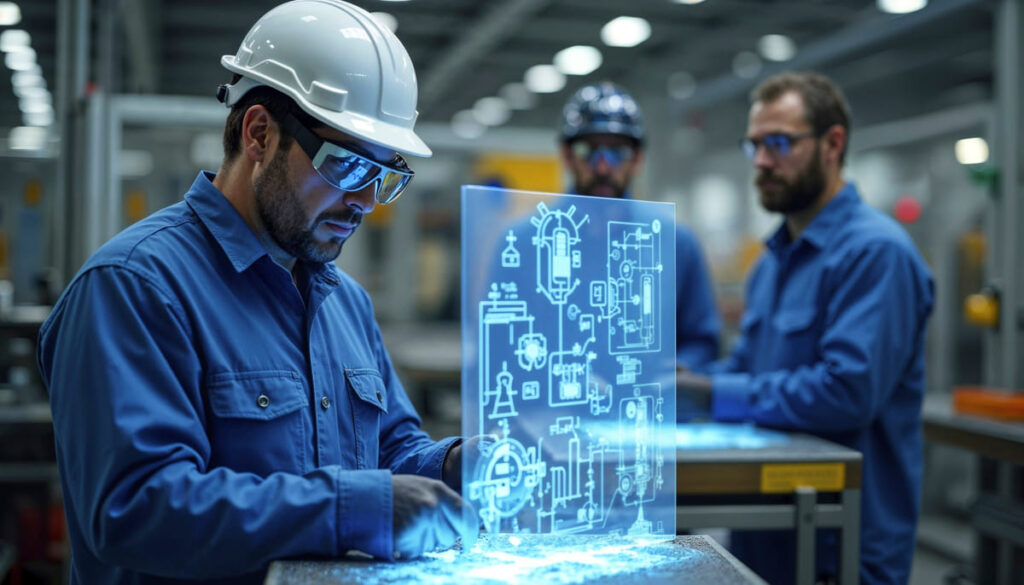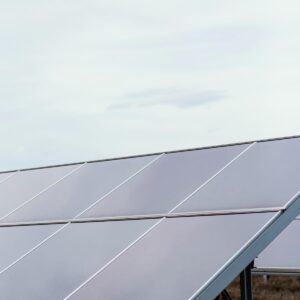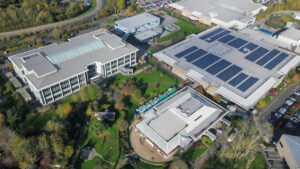AI-Powered Construction Tools refer to advanced hardware and software systems in construction that leverage artificial intelligence to perform or assist with tasks on job sites. These tools include autonomous machines, smart devices, and intelligent platforms that can analyze data, make decisions, and control equipment with minimal human input. In 2025, such tools have moved from pilot projects to practical deployment, helping to tackle longstanding industry challenges. With the construction sector facing labor shortages, safety risks, and pressure for efficiency, AI-powered solutions are increasingly vital.
They enable higher productivity, improved on-site safety, and more sustainable operations by taking on complex or repetitive tasks that were traditionally done manually. From self-driving excavators that dig and grade continuously, to algorithms that optimize project schedules, AI-powered tools are transforming how modern job sites operate. In the sections below, we explore the top 7 AI-driven construction technologies revolutionizing job sites in 2025, including real examples and practical benefits.
Table of Contents
Tool 1: Autonomous Excavation Robots
Autonomous excavation robots are heavy construction machines (excavators, bulldozers, etc.) equipped with AI-driven control systems that allow them to perform earthmoving tasks with minimal human intervention. AI enables these robots to perceive and navigate the terrain, avoid obstacles, and execute precise digging or grading plans. They integrate technologies like GPS positioning, LiDAR scanners, and computer vision cameras to map their surroundings in real time. Advanced machine learning algorithms process this sensor data to identify target dig locations, track elevation contours, and adjust movements to achieve exact specifications. The result is a robot that can trench or excavate with accuracy comparable to an experienced operator – and often continuously, without fatigue.
Example in action: On a recent solar farm project, contractors deployed an AI-guided excavator retrofitted with an autonomy kit to dig cable trenches. The system, known as the Built Robotics “Exosystem,” uses AI software and sensors to guide a standard 15-ton excavator along trench layouts autonomously. In the field, excavators equipped with this AI co-pilot have been used to dig hundreds of miles of trench for energy and infrastructure jobs, operating with only minimal supervision.
The autonomous excavator can detect underground obstacles or terrain changes and pause or adjust as needed, significantly reducing rework. These robots excel at repetitive earthmoving tasks – for instance, precision trenching and grading – working day and night with consistent accuracy. This not only speeds up project timelines but also improves safety by removing human operators from hazardous environments (e.g. trench cave-ins or operating in bad weather). In short, autonomous excavation robots demonstrate how AI can bring 24/7 productivity and surgical precision to heavy civil work on job sites.
Tool 2: AI-Driven Project Scheduling Platforms
AI-driven project scheduling platforms are software tools that use machine learning and data analytics to plan and update construction schedules more intelligently than traditional methods. These platforms ingest huge amounts of project data – past schedules, productivity rates, crew availability, supply chain info – and then optimize labor allocation and task sequencing to find the most efficient path to project completion. Instead of relying solely on human planners, the AI can quickly evaluate millions of scheduling permutations or learn from historical project outcomes.
Machine learning is used to predict and prevent delays: for example, by analyzing thousands of past construction schedules, an AI scheduling system can forecast which activities in a new project are most likely to run late or cause bottlenecks. Project planners receive risk alerts highlighting these high-probability delay points. This allows teams to proactively adjust sequences or add resources to critical tasks before problems occur.
Some platforms also integrate with building models (4D BIM), using AI to detect clash or overlap issues in the schedule. For instance, the AI might catch that two trades are scheduled in the same space at the same time, a conflict that would cause on-site delays. One construction firm noted that combining AI with BIM could automatically detect building component clashes and suggest more efficient phasing of work based on material and schedule requirements.
Not only do these tools optimize plans, they can adapt in real time. If an activity finishes early or a delivery is late, the AI platform can resequence remaining work on the fly, minimizing idle time. Modern AI scheduling software often features a “generative scheduling” capability: given the project constraints and goals, it auto-generates multiple detailed schedule options for managers to compare. As a practical example, a contractor facing a 30-day delay on a large data center project turned to an AI-driven scheduling tool.
The system ran countless scenarios and identified a revised sequence that recovered the lost time, protecting an estimated $32 million in project revenue. Similarly, on major infrastructure programs like HS2 in the UK, AI-based schedule risk analysis has provided “unbiased insight into potential risks to schedule and cost,” enabling preventive actions that keep the overall program on track. In sum, AI-powered scheduling platforms improve decision-making by finding optimizations and flagging risks far beyond the capacity of manual methods.
Suggested article to read: AI for Construction Vehicle Automation: Neural Networks and Machine Learning Approaches

Tool 3: Smart Wearables for Worker Safety
Smart wearables are intelligent personal protective equipment (PPE) – such as helmets, vests, wristbands, or goggles – embedded with sensors and AI algorithms to monitor worker health and safety in real time. These devices continuously track metrics like heart rate, body temperature, movement, posture, and location. The AI in wearable safety gear analyzes this data to detect signs of danger or fatigue and then issues instant alerts to the worker or supervisors.
For example, smart helmets now come with built-in accelerometers and gyroscopes that can detect if a worker has tripped or fallen. If a fall or a sudden impact is detected, the helmet’s AI can automatically trigger an emergency call or alarm. The Guardio Armet Pro helmet is one such device – it senses a hard fall and will automatically call for help, even transmitting the worker’s location to rescue teams.
This quick response can be life-saving in situations where an injured worker might be alone. Another type of wearable, intelligent safety vests like the Spot-r system, create a connected network on site. Each vest has a sensor that detects slips, trips, or a worker becoming motionless, and immediately sends an alert to a central dashboard. Supervisors can see exactly who needs help and where, enabling fast medical attention. The system can also issue evacuation alarms to all workers if a site-wide hazard is detected.
AI wearables also tackle less acute but equally important issues like fatigue and heat stress. Fatigue-monitoring headbands or watches use EEG brainwave sensors or ocular cues (blink rates, microsleeps) to gauge if an operator is overly tired. If the AI determines a worker’s alertness is falling below a safe threshold, it can prompt them to take a break or notify a manager – preempting accidents caused by microsleep or slow reaction times.
Similarly, smart patches can monitor body temperature and sweat rate in hot weather, warning workers to hydrate or cool down to prevent heat stroke. In one pilot program, a major energy company equipped its crews with an AI-driven fatigue management wearable called “Readi” to predict who might be at risk of exhaustion each day. This gave both workers and managers actionable insights to schedule rest before an incident occurred.
The impact of these AI-powered wearables is a significant reduction in workplace incidents and faster emergency response. The real-time alerts they provide have been credited with preventing countless accidents – for instance, by warning a worker that they are entering a restricted zone near heavy machinery, or by notifying all nearby personnel of an active crane lift. By alerting staff to hazards or health risks immediately, smart wearables help create a proactive safety culture on site. Many contractors report that since adopting wearables, they have seen lower injury rates and improved compliance with safety protocols. In essence, AI-powered safety wearables act as an ever-vigilant guardian for workers, intervening the moment conditions become unsafe.
Tool 4: AI-Based Quality Inspection Drones
Quality inspection drones are unmanned aerial vehicles outfitted with high-resolution cameras and AI vision software, used to inspect construction work and identify defects faster and more accurately than traditional methods. These drones can autonomously fly around structures – such as building façades, bridges, or large facilities – capturing a constant stream of images. The AI then analyzes the imagery in real time to spot issues like cracks in concrete, misaligned components, corrosion, water leaks, or other material defects that might be invisible or hard to reach from the ground.
Using AI-based drones for inspections offers a huge advantage in speed and coverage. A task that might take a human inspector weeks of climbing scaffolds or suspending from ropes can be done by a drone fleet in hours, with no risk to personnel. For instance, an inspection was conducted on a 15-story housing block using AI-powered drones rather than manual inspectors. The drones scanned the entire exterior and the AI automatically detected and marked tiny cracks and facade weaknesses across thousands of high-resolution photos
In just 72 hours, the system produced a complete defect map of the building – something that would have taken many weeks using traditional scaffolding inspections. Importantly, the AI did not miss spots that a human might overlook; it flagged subtle hairline cracks and areas of potential water ingress that warranted repair. This comprehensive, rapid assessment allowed the building owner to prioritize repairs much more effectively.
Beyond façades, AI inspection drones are used for infrastructure like bridges, roadways, and runways. They can be trained to recognize patterns of damage (for example, the distinctive line patterns of asphalt cracks or the spalling on concrete surfaces). AI algorithms measure crack lengths and widths from images, helping engineers evaluate severity. Drones can also compare current images to digital plans or previous scans, automatically highlighting any deviations from design specifications or any new deformation.
The result is a dramatic improvement in both inspection speed and accuracy. One IBM research project demonstrated that an AI drone system could scan an airport runway and identify over 15,000 cracks, ranking them by severity – all in a fraction of the time a ground crew would need. By catching quality issues early (while they’re still minor), contractors can fix problems before they escalate into costly rework or safety hazards. Overall, AI-powered inspection drones ensure higher construction quality by giving project teams deep, timely insight into the state of every building element, even in hard-to-reach places. They transform inspections from a slow, labor-intensive chore into a fast, data-driven process.
Tool 5: Predictive Maintenance Platforms for Equipment
Predictive maintenance platforms apply AI to the maintenance of construction equipment (cranes, excavators, trucks, generators, etc.), with the goal of predicting machine failures before they happen. This approach relies on IoT sensors installed on machinery that continuously monitor parameters like engine temperature, oil pressure, vibration frequencies, hydraulic flow, and electrical currents. The AI platform aggregates and analyzes this sensor data in real time, looking for anomalies or trends that indicate a component might be wearing out.
For example, if a crane’s gearbox begins to vibrate slightly more than usual or a compressor’s motor draws increasing amperage, the AI system will detect those subtle changes. Machine learning models, trained on historical failure data, recognize the early signature of an impending issue – perhaps a misaligned gear or a bearing that will seize.
The platform then alerts maintenance crews with a diagnosis (e.g. “inspect gearbox alignment on Crane #3”) so that they can intervene during scheduled downtime. By fixing or replacing the part before a catastrophic failure, the equipment avoids an unexpected breakdown. This is a major shift from reactive maintenance (fix it after it breaks) or even routine preventive maintenance (fix on a fixed schedule regardless of condition). AI allows maintenance to be performed “just in time,” only when needed based on actual machine condition.

The result is dramatically improved equipment uptime and lower repair costs. Studies have shown that implementing AI-driven predictive maintenance can reduce unexpected equipment downtime by around 25–30% on average, and in some cases even up to 70% less unplanned downtime for companies that fully embrace the strategy. Fewer surprise failures mean construction crews face fewer stoppages waiting on repairs, which helps projects stay on schedule. There are safety benefits as well – catching issues early prevents dangerous equipment accidents (like a crane collapse due to undetected fatigue).
Modern predictive maintenance platforms often include user-friendly dashboards and mobile apps that provide equipment managers with real-time health scores for each asset. For instance, a fleet manager can see that a particular excavator’s hydraulic pump has an 80% likelihood of failure in the next 50 hours, based on sensor trends and the AI’s predictive model.
They can then proactively schedule a replacement of that pump during the next off-shift, avoiding a mid-operation failure. Some systems also create digital twins of equipment (virtual models that mirror the condition of the real machine) to simulate how a failure might propagate if not addressed. By leveraging these AI insights, construction firms optimize their maintenance resources – focusing efforts where and when they’re needed most. In essence, AI-powered predictive maintenance turns equipment care from an art into a science, extending the lifespan of machines and eliminating costly downtime surprises.
Tool 6: Generative Design Software
Generative design software in construction uses AI algorithms to automatically generate and evaluate multiple design options for a project, based on defined goals and constraints. In the pre-construction planning stage, architects and engineers input the basic requirements – for example, the building footprint, zoning rules (height limits, setbacks), desired number of units or offices, structural criteria, cost targets, and so on. The generative design AI then goes to work producing a vast array of design permutations that satisfy these constraints. This could include different building massing configurations, floor plan layouts, structural framing patterns, or site plans. The AI essentially acts as a supercharged “digital architect,” iterating through solutions much faster than humans can.
What makes AI generative design especially powerful is its ability to optimize for multiple objectives simultaneously. For instance, it might generate building designs that maximize natural light and views for all apartments while also minimizing energy use and meeting a strict budget per square foot.
Each design alternative is evaluated against the project’s goals, and the software provides analysis – like estimated cost, structural efficiency, or compliance checklists – for each option. This enables the team to compare options quantitatively. Thousands of design options can be created and analyzed in hours, a process that would take humans months. The AI uses techniques like evolutionary algorithms to “evolve” better and better solutions over successive generations of design, honing in on the best trade-offs.
Case in point: A developer planning a new urban office building used an AI generative design platform (Autodesk’s Spacemaker) during the concept phase. The AI quickly explored numerous site layouts, adjusting the building placement and shape to test various scenarios.
It considered sunlight exposure, wind patterns, noise from a nearby highway, and construction costs. Planners were presented with a handful of top-performing schemes, including some creative layouts they might not have conceived manually. Ultimately, they selected a hybrid design that optimized floor area while still meeting strict daylight and noise criteria for occupants.
By using AI in these early stages, the team cut down weeks of manual drafting and avoided costly late design changes. In fact, early case studies of generative design tools have shown that building owners can save millions of dollars by identifying the most efficient design options upfront. The AI might discover, for example, a structural design that uses 20% less steel while maintaining strength, or a layout that yields higher rental income due to better unit mix – value that goes straight to the bottom line.
Generative design doesn’t replace human architects or engineers; rather, it augments their creativity. The design team still sets the vision and makes the final decisions, but they do so equipped with a rich, data-backed menu of options that AI helped create. By automating the heavy lifting of exploring the design solution space, AI frees professionals to focus on fine-tuning and innovation.
As a result, projects benefit from smarter designs that balance cost, performance, and compliance, all achieved in a fraction of the time of traditional design cycles. In 2025, many firms use generative design AI not only for buildings but also for optimizing construction processes themselves (like formwork layouts or crane positions), showing the broad potential of this technology in construction planning.
Tool 7: Digital Twin Monitoring Systems
Digital twin monitoring systems involve creating a live digital replica of a construction project – integrating building information models (BIM), real-time field data, and AI analytics. The digital twin is a dynamic virtual model that mirrors the state of the physical construction site at any given moment. AI plays a key role in syncing the twin with reality and extracting useful insights. Various data streams feed into the digital twin: project schedules, sensor readings (from equipment GPS, RFID-tagged materials, concrete maturity sensors, etc.), drone imagery, and even live data from worker wearables. The AI system continuously processes these inputs to update the virtual model and highlight deviations between the planned model and the as-built progress.
In practice, a digital twin platform might show a 3D model of the building under construction, color-coded to indicate which elements are installed, which are in progress, and which are delayed. As work is completed on site, the AI updates the model’s status – for example, marking a concrete slab as poured once IoT sensors or drone scans confirm its presence. This gives project managers an intuitive, up-to-the-minute view of progress without having to walk the entire site
AI can also compare the real-time twin against the schedule and automatically flag any discrepancies or lagging tasks. One project’s digital QA/QC system used a twin to monitor construction progress and ensure it was adhering to the plan and specifications; any variance (like a wall placed out of correct alignment or a schedule slip in a sub-section of the build) was identified quickly for correction. By catching issues early – for instance, noticing that a critical structural component has not been installed by the scheduled date – the team can intervene before it impacts the whole project timeline.

Digital twins also greatly assist in tracking material flow and logistics. All materials can be virtually represented in the twin. If a shipment of steel beams is delayed in transit, the twin (linked with supply chain data) can highlight that those beams aren’t yet on site, and AI might recommend resequencing some tasks to avoid downtime. Conversely, when materials do arrive (scanned by an RFID reader at the gate), the twin updates inventory and can direct crews to where those materials need to go. This ensures nothing falls through the cracks – materials are neither lost nor installed in the wrong place.
A powerful example of the impact of digital twins comes from the High Speed 2 (HS2) rail project in the UK. In the redevelopment of Euston Station, the team employed a comprehensive digital twin to plan and monitor complex enabling works. The virtual model, fed by real site data and scheduling AI, allowed planners to simulate construction sequences and coordination in a virtual space before doing them in reality.
The result was a smoother execution that saved an estimated £700,000 and roughly 24 weeks on the project’s schedule. This kind of outcome – significant cost and time savings – underscores the value of having a continuously updated “source of truth” model. Project stakeholders (owners, contractors, engineers) can all log into the digital twin dashboard to get insights for real-time decision-making. They can query the AI: “Is the project on track? Where are the bottlenecks? What happens if we change X?” and the system can simulate scenarios or provide answers grounded in data.
In summary, digital twin monitoring systems serve as an AI-powered command center for modern construction sites. They provide real-time visibility and predictive foresight, enabling managers to respond swiftly to issues and make informed decisions based on the current state of the project. By synchronizing the physical and digital worlds, digital twins help construction projects stay efficient, coordinated, and adaptable to change.
FAQs
How are AI-Powered Construction Tools improving safety on job sites?
AI-Powered Construction Tools improve safety by reducing workers’ exposure to dangerous tasks and environments. For example, autonomous robots can operate in hazardous areas (like handling toxic materials or working at height) so humans don’t have to. Smart safety wearables monitor workers’ health signs and surroundings in real time, warning them of risks (such as fatigue, falls, or proximity to heavy equipment) and automatically alerting supervisors to emergencies. By providing early warnings, removing people from harm’s way, and ensuring protective measures are in place, these AI tools significantly lower the likelihood of accidents and injuries on site.
What are the challenges of implementing AI-Powered Construction Tools?
Implementing AI-Powered Construction Tools can pose a few challenges. Firstly, there is the cost of acquisition and training – advanced robots or software platforms require a substantial investment, and staff need to be trained to use them effectively. Secondly, companies may face integration issues: new AI systems must be integrated with existing workflows, machines, or IT systems (for instance, connecting a digital twin platform with current BIM software and sensor networks).
There can also be resistance to change; field crews and managers might be initially hesitant to trust AI recommendations or autonomous operation. Lastly, data quality and volume are challenges – AI systems only perform well if fed lots of accurate data, so firms must put effort into data collection and management. Overcoming these hurdles involves careful change management, choosing scalable solutions, and starting with pilot projects to demonstrate value.
Which AI-Powered Construction Tools are most widely used in 2025?
In 2025, some of the most widely used AI-powered tools in construction include AI-driven project management software, predictive safety systems, and autonomous equipment. On the software side, many companies use AI-based scheduling and planning platforms (often part of larger project management suites) to optimize schedules and run “what-if” scenarios. Predictive safety tools like wearables (smart helmets, vests) and computer vision monitoring (cameras on site that use AI to detect unsafe behavior) are increasingly common on large job sites focused on safety.
In terms of hardware, semi-autonomous or autonomous machinery is making headway – for example, robotic total stations for layout, drone surveyors for progress tracking, and autonomous excavators or bulldozers in controlled environments (such as mining or remote site work). While fully autonomous robots are not yet everywhere, it’s now common to see drones for inspection and AI-assisted heavy equipment on major projects. These tools have gained popularity because they address key industry needs: saving time, reducing errors, and improving safety and productivity.
Is it true that AI-Powered Construction Tools will replace human workers on construction sites?
It’s not true that AI-powered tools will outright replace human workers on construction sites, at least not in the foreseeable future. What we’re seeing instead is a shift in the nature of work: AI and robots handle specific tasks, especially those that are repetitive, dangerous, or highly data-driven, and in doing so they augment human labor. For example, a drone may replace the need for a person to climb and inspect a roof, but that drone still needs a trained operator and the data it collects must be interpreted by engineers.
Autonomous excavators can dig according to a plan, but human crews are still required to plan the work, set up the machine, and handle tasks that the robot cannot. In essence, AI-powered tools are viewed as assistants or collaborators – they help humans work more safely and efficiently.
Conclusion
Across the construction industry, AI-powered construction tools are improving efficiency, safety, and decision-making on job sites in tangible ways. Autonomous robots are handling dangerous or repetitive tasks with precision and speed, reducing project durations while keeping workers out of harm’s way. Intelligent scheduling and design software are taking on complex planning work, uncovering optimal solutions and spotting risks that humans might miss – this leads to tighter schedules and better-designed structures delivered with fewer hiccups.
On the ground, AI-driven wearables and drones are providing eyes and ears that never tire: preventing accidents through early warnings, and ensuring quality by catching defects early. Meanwhile, predictive maintenance systems minimize costly downtime by keeping equipment in peak condition, and digital twins tie everything together by giving project leaders an unprecedented real-time overview of site operations.
Crucially, these AI tools augment the construction workforce rather than replace it. They handle data-heavy analysis and grunt work, freeing human professionals to focus on skilled decision-making, creative problem-solving, and supervision that still require human judgment. The year 2025 finds the construction sector at a new high-tech frontier – one where algorithms and machines collaborate with builders to achieve safer, faster, and smarter construction. Companies embracing these AI-powered tools are seeing projects delivered more predictably and with higher quality, all while safeguarding their crews and assets. As adoption continues to grow, AI-Powered Construction Tools are set to become as standard on job sites as the crane or computer, heralding a more efficient and resilient construction industry for years to come.
Resources:
- Hitachi Construction Machinery Europe. (2025). Autonomous excavators – a new era.
- Construction & Civil Engineering Magazine. (2023). AI-powered portfolio risk management is latest approach from BAM and nPlan partnership.
- Construction Dive. (2024). AI-driven BIM shows promise to improve clash detection at Warfel.
- CONEXPO-CON/AGG. (2025). 5 Wearable Devices for Modern Construction Sites.
- Iprosurv. (2023). Drone inspection of a 15-storey tower block for EWI concerns.
- AZoBuild. Singh, A. (2025). Predictive Maintenance in Construction: A Proactive Approach to Efficiency and Safety.
- Equipment Journal. (2023). Built Robotics develops the 1st fully autonomous solar piling system.
For all the pictures: Freepik
Suggested article for reading:
4 Types of Fire Detection Systems and Where to Use Each One in 2025
Top 7 Sustainable Digital Fabrication Innovations Leading the Green Revolution
5 Tips on Choosing a Construction Company for Residential and Commercial Projects
8 Key Features of Next-Gen Fire Detection Systems
10 Digital Fabrication Trends Shaping the Future of Smart Manufacturing





